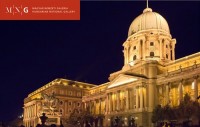The Last Day of a Condemned Man, which he began in Dusseldorf in 1869, brought Munkácsy immediate acknowledgment : he won a gold medal at the Salon exhibition in Paris in the spring of 1870. The success of The Last Day of a Condemned Man is owed in part to its Hungarian theme, which audiences in Paris found exotic. The condemned man is visited for the last time by his relatives and acquaintances. From his sobbing wife, the unsuspecting child, and the horrified visitors to the impassive prison guard leaning against the wall, the characters in the painting reveal every kind of emotional reaction through their facial expressions and gestures. The nature of the man’s crime is unknown - was he a freedom fighter or a murderous thief? This uncertainty endows the painting with a peculiar emotional tension. Professional success was followed by financial as well, as the painting was purchased, almost from the easel, by William P. Wiltach, a wealthy American art collector and was only acquired by the Hungarian National Gallery in 1965.
en

